ignition CITROEN DS3 CABRIO DAG 2015 Handbook (in English)
[x] Cancel search | Manufacturer: CITROEN, Model Year: 2015, Model line: DS3 CABRIO DAG, Model: CITROEN DS3 CABRIO DAG 2015Pages: 404, PDF Size: 13.93 MB
Page 158 of 404

deactivation
In exceptional conditions (starting a vehicle which is bogged down, stuck in snow, on soft
g
round...), it may be advisable to deactivate the
A
SR and ESP systems, so that the wheels can
m
ove freely and regain grip.
F
P
ress the "ESP OFF" button, located on
the
left below the steering wheel.
Illumination
of the lamp in the button indicates
t
hat
t
he
A
SR
a
nd
ES
P
s
ystems
a
re
d
eactivated.
Reactivation
These systems are reactivated automatically each time the ignition is switched back on or
f
rom 30 mph (50 km/h) except 1.6 litre
(THP 150, THP 155 and THP 160) and
R ACING
petrol engines.
F
P
ress the "ESP OFF" button again to
r
eactivate
t
hem
ma
nually.
Operating fault
The ESP/ASR systems offer exceptional s afety i n n ormal d riving, b ut
t
his should not encourage the driver to
t
ake extra risks or drive at high speed.
The
correct functioning of these
s
ystems depends on observation of the
ma
nufacturer's
r
ecommendations
o
n:
-
w
heels (tyres and rims),
-
b
raking components,
-
el
ectronic
c
omponents,
-
a
ssembly and repair procedures.
After
an impact, have these systems
c
hecked by a CITROËN dealer or a
q
ualified
w
orkshop.
Illumination
of this warning lamp in
t
he instrument panel and the lamp in
t
he "ESP OFF" button, accompanied
b
y an audible signal and a message
i
n
the
multifunction screen, this indicates a
m
alfunction of these systems.
Have
it checked by a CITROËN dealer or a
q
ualified
w
orkshop.
Page 162 of 404
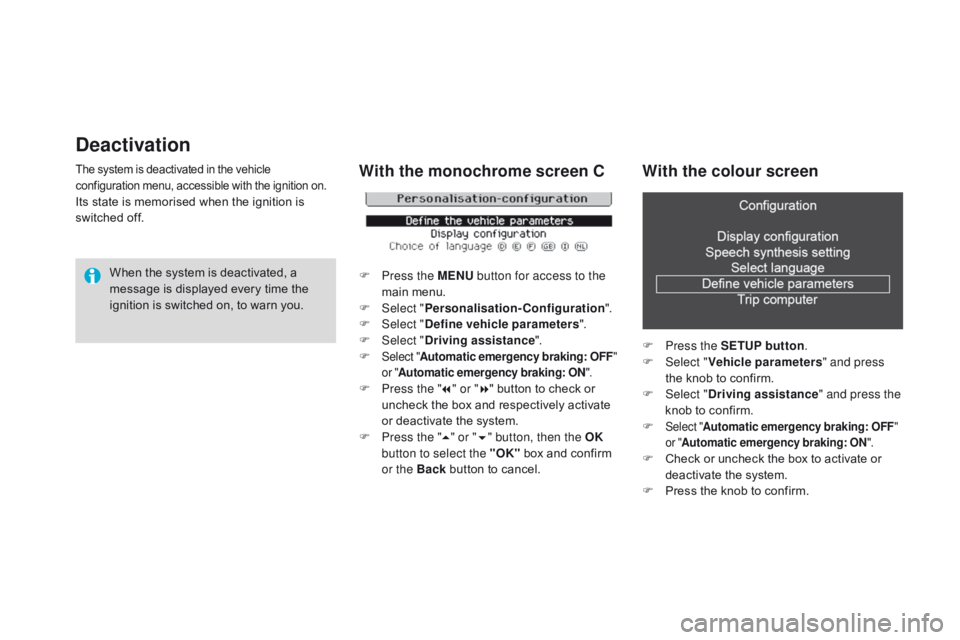
deactivation
The system is deactivated in the vehicle configuration menu, accessible with the ignition on.
Its state is memorised when the ignition is switched off.
When
the system is deactivated, a
m
essage is displayed every time the
i
gnition is switched on, to warn you.
With the monochrome screen c
F Press the MENU button for access to the
main menu.
F
Sel
ect "Personalisation-
co
nfiguration".
F
Sel
ect "
def
ine vehicle parameters ".
F
Sel
ect "
dr
iving assistance ".
F
Select " Automatic emergency braking: OFF "
or " Automatic emergency braking : ON".
F Press the " 7" or " 8" button to check or u
ncheck the box and respectively activate
o
r deactivate the system.
F
P
ress the " 5" or " 6" button, then the OK
button to select the "OK"
box and confirm
o
r the Back
button to cancel.
With the colour screen
F Press the SETUP button .
F Sel ect "Vehicle parameters " and press
the
knob to confirm.
F
Sel
ect "
dr
iving assistance " and press the
knob
to confirm.
F
Select " Automatic emergency braking: OFF "
or " Automatic emergency braking: ON ".
F Check or uncheck the box to activate or d
eactivate the system.
F
P
ress the knob to confirm.
Page 164 of 404
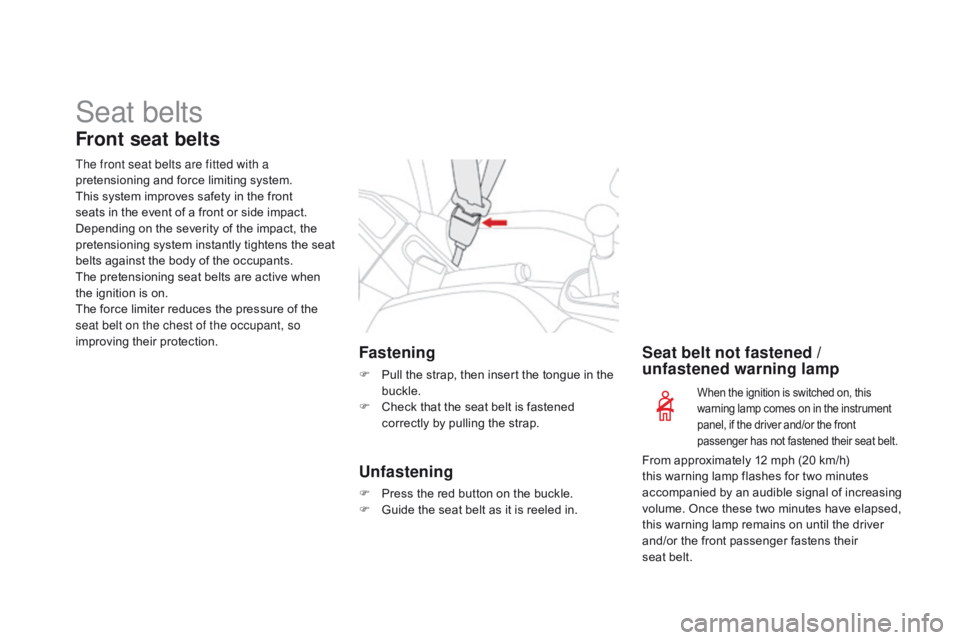
Seat belts
Front seat belts
The front seat belts are fitted with a
pretensioning and force limiting system.
This
system improves safety in the front
s
eats in the event of a front or side impact.
D
epending on the severity of the impact, the
p
retensioning system instantly tightens the seat
b
elts against the body of the occupants.
The
pretensioning seat belts are active when
t
he ignition is on.
The
force limiter reduces the pressure of the
s
eat belt on the chest of the occupant, so
improving
their protection.
Fastening
F Pull the strap, then insert the tongue in the buc
kle.
F
C
heck that the seat belt is fastened
c
orrectly by pulling the strap.
Unfastening
F Press the red button on the buckle.
F G uide the seat belt as it is reeled in.
Seat belt not fastened /
unfastened warning lamp
When the ignition is switched on, this warning lamp comes on in the instrument p
anel, if the driver and/or the front
p
assenger has not fastened their seat belt.
From approximately 12 mph (20 km/h) this warning lamp flashes for two minutes
a
ccompanied by an audible signal of increasing
v
olume. Once these two minutes have elapsed,
t
his warning lamp remains on until the driver
a
nd/or the front passenger fastens their
seat
belt.
Page 167 of 404
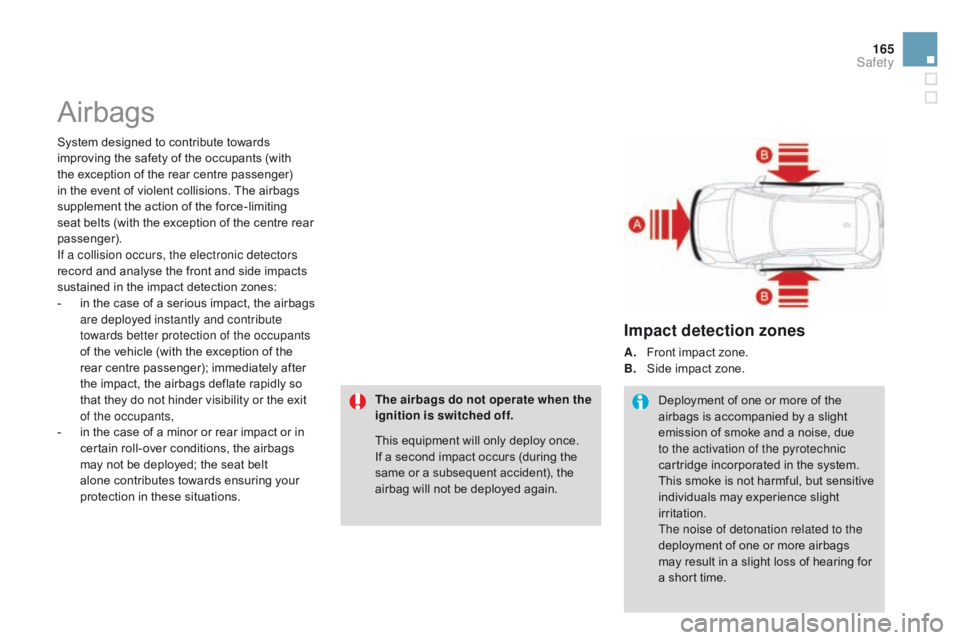
165
DS3_en_Chap08_securite_ed01-2014
Airbags
System designed to contribute towards improving the safety of the occupants (with
t
he exception of the rear centre passenger)
i
n the event of violent collisions. The airbags
s
upplement the action of the force-limiting
s
eat belts (with the exception of the centre rear
p
assenger).
If a collision occurs, the electronic detectors
record
and analyse the front and side impacts
s
ustained in the impact detection zones:
-
i
n the case of a serious impact, the airbags
a
re deployed instantly and contribute
towards better protection of the occupants
of
the vehicle (with the exception of the
r
ear centre passenger); immediately after
t
he impact, the airbags deflate rapidly so
t
hat they do not hinder visibility or the exit
o
f the occupants,
-
i
n the case of a minor or rear impact or in
c
ertain roll-over conditions, the airbags
m
ay not be deployed; the seat belt
a
lone contributes towards ensuring your
p
rotection in these situations. This
equipment will only deploy once.
I
f a second impact occurs (during the
s
ame or a subsequent accident), the
a
irbag will not be deployed again.
Impact detection zones
A. Front impact zone.
B. S ide impact zone.
Deployment
of one or more of the
a
irbags is accompanied by a slight
e
mission of smoke and a noise, due
t
o the activation of the pyrotechnic
cartridge
incorporated in the system.
This
smoke is not harmful, but sensitive
i
ndividuals may experience slight
ir
ritation.
The noise of detonation related to the
deployment
of one or more airbags
m
ay result in a slight loss of hearing for
a
short time.
The airbags do not operate when the
ignition is switched off.
Safety
Page 169 of 404
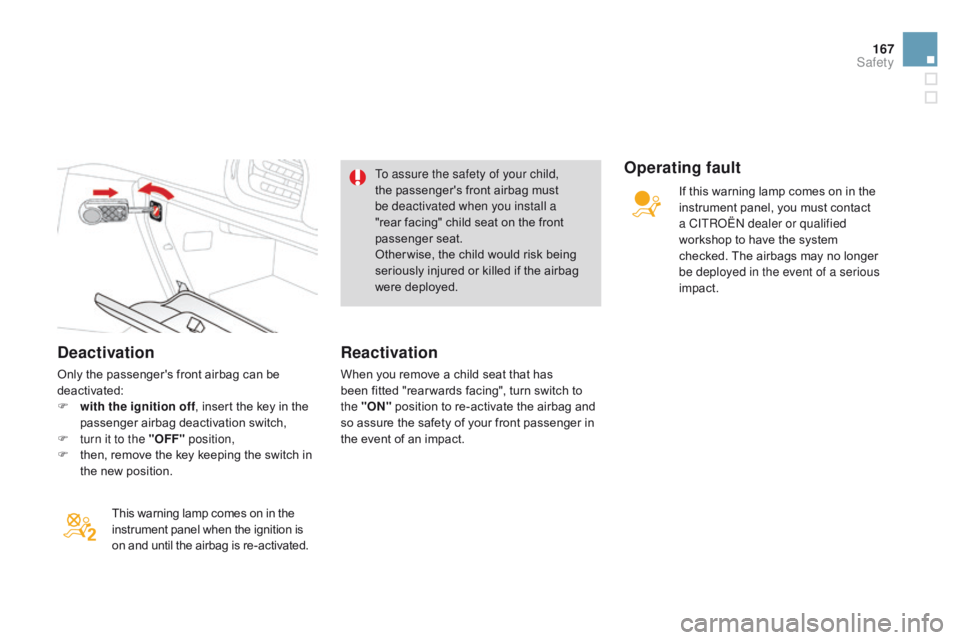
167
DS3_en_Chap08_securite_ed01-2014
deactivation
Only the passenger's front airbag can be deactivated:
F
w
ith the ignition off ,
insert the key in the
p
assenger airbag deactivation switch,
F
t
urn it to the "OFF" position,
F
t
hen, remove the key keeping the switch in
t
he new position.
This
warning lamp comes on in the
i
nstrument panel when the ignition is
o
n and until the airbag is re-activated.To assure the safety of your child,
the
passenger's front airbag must
b
e deactivated when you install a
"rear facing" child seat on the front
p
assenger
sea
t.
Other wise, the child would risk being
s
eriously injured or killed if the airbag
w
ere deployed.
Reactivation
When you remove a child seat that has b
een fitted "rear wards facing", turn switch to
t
he "ON"
position to re-activate the airbag and
s
o assure the safety of your front passenger in
t
he event of an impact.
Operating fault
If this warning lamp comes on in the instrument panel, you must contact
a C
ITR
oË
N dealer or qualified
workshop
to have the system
c
hecked. The airbags may no longer
b
e deployed in the event of a serious
impact.
Safety
Page 192 of 404

DS3_en_Chap10_info-pratiques_ed01-2014
Fuel tankFuel tank capacity: approximately 50 litres (petrol) or 46 litres (diesel) or 33 litres (LPG); (de pending on version: approximately 30 litres
(petrol or d iesel)).
Low fuel level
Filling
A label affixed to the inside of the flap reminds you of the type of fuel to be used depending on
y
our
eng
ine.
Additions
of fuel must be of at least 7 litres, in
o
rder to be registered by the fuel gauge.The
key cannot be removed from the
l
ock until the cap is refitted.
Opening
the filler cap may create a
n
oise caused by an inrush of air. This
v
acuum is entirely normal, resulting
f
rom the sealing of the fuel system.
To
fill the tank safely:
F
t
he engine must be switched off,
F
o
pen the fuel filler flap,
F
i
nsert the key in the cap, then turn it to the
l
eft,F
r emove the cap and hook it onto the clip
l
ocated on the inside of the flap,
F
f
ill the tank, but do not continue after the
3rd cut- off of the pump ;
this could cause
m
alfunctions.
When
you have filled the tank:
F
p
ut the cap back in place,
F
t
urn the key to the right, then remove it
f
rom the cap,
F
c
lose the flap.
When
the fuel tank minimum level
i
s reached this warning lamp comes
o
n on the instrument panel. When it
f
irst comes on there remains approximately
5 litres of fuel in the tank.
You must refuel as soon as possible to avoid
r
unning out of fuel.
If you run out of fuel (Diesel), refer also to the
"Checks"
s
ection.
With Stop & Start, never refuel with the
system in STOP mode; you must switch
o
ff the ignition with the key.
Page 195 of 404
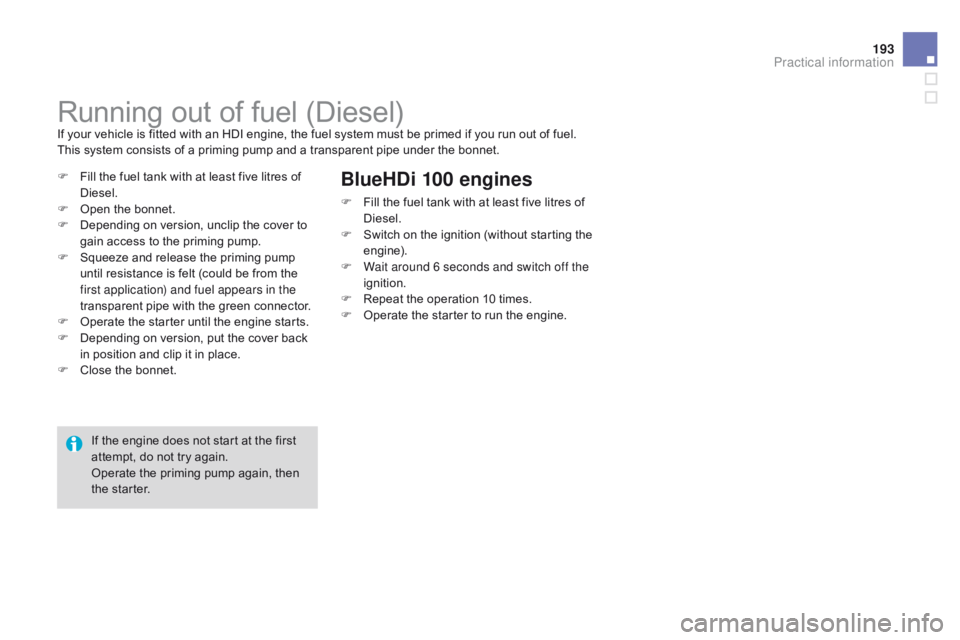
193
DS3_en_Chap10_info-pratiques_ed01-2014
Running out of fuel (Diesel)If your vehicle is fitted with an HDI engine, the fuel system must be primed if you run out of fuel.
T his system consists of a priming pump and a transparent pipe under the bonnet.
F
F
ill the fuel tank with at least five litres of
D
iesel.
F
O
pen the bonnet.
F
D
epending on version, unclip the cover to
g
ain access to the priming pump.
F
S
queeze and release the priming pump
u
ntil resistance is felt (could be from the
f
irst application) and fuel appears in the
transparent
pipe with the green connector.
F
O
perate the starter until the engine starts.
F
D
epending on version, put the cover back
i
n position and clip it in place.
F
C
lose the bonnet.
BlueHdi 100 engines
F Fill the fuel tank with at least five litres of D
iesel.
F
S
witch on the ignition (without starting the
e
ngine).
F
W
ait around 6 seconds and switch off the
ignition.
F
R
epeat the operation 10 times.
F
O
perate the starter to run the engine.
If
the
engine
does
not
start
at
the
first
a
ttempt,
do
not
try
again.
Operate
the
priming
pump
again,
then
t
he
starter.
Practical information
Page 197 of 404
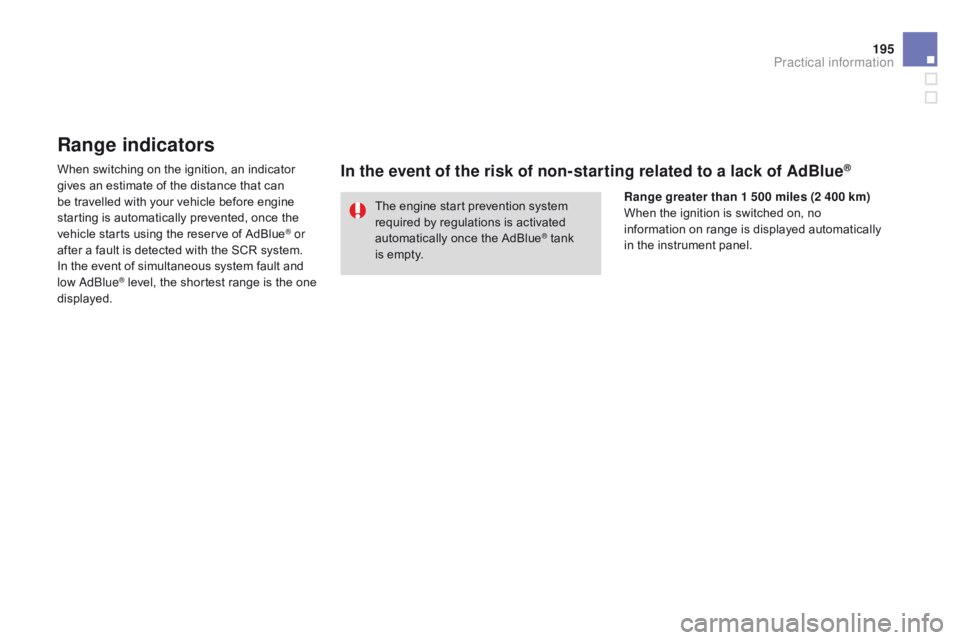
195
DS3_en_Chap10_info-pratiques_ed01-2014
Range indicators
When switching on the ignition, an indicator gives an estimate of the distance that can
b
e travelled with your vehicle before engine
s
tarting is automatically prevented, once the
v
ehicle starts using the reserve of AdBlue
® or
after
a
fault
is
detected
with
the
SCR
system.
In
the
event
of
simultaneous
system
fault
and
l
ow
a
d
blu
e
® level, the shortest range is the one d
isplayed. The
engine start prevention system
r
equired by regulations is activated
a
utomatically once the AdBlue
® tank i
s
empty.
In the event of the risk of non-starting related to a lack of AdBlue®
Range greater than 1 500 miles (2 400 km)
When the ignition is switched on, no
i
nformation on range is displayed automatically
i
n the instrument panel.
Practical information
Page 198 of 404
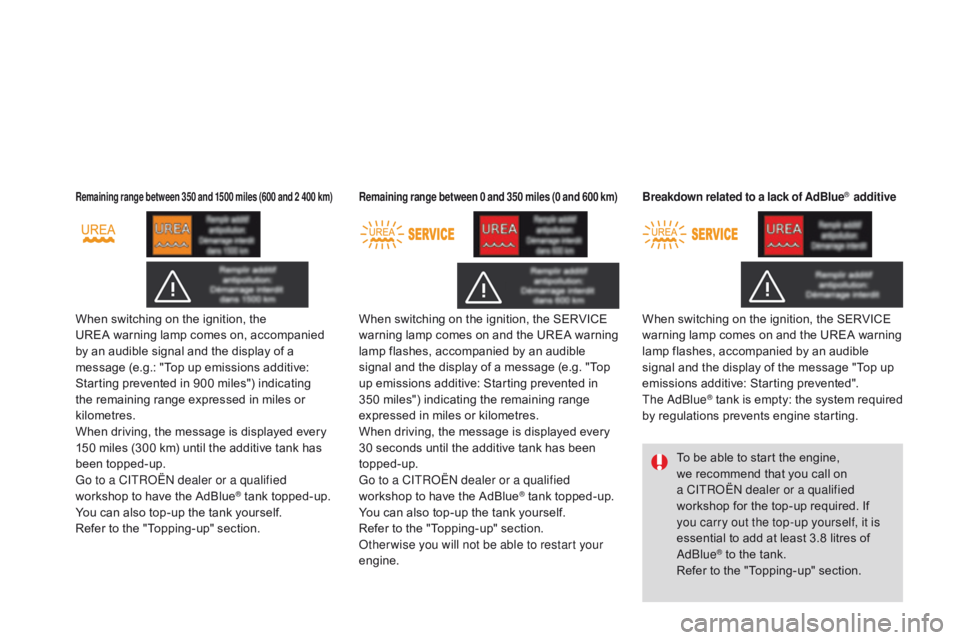
DS3_en_Chap10_info-pratiques_ed01-2014
Remaining range between 350 and 1500 miles (600 and 2 400 km)
When switching on the ignition, the UREA warning lamp comes on, accompanied
b
y an audible signal and the display of a
m
essage (e.g.: "Top up emissions additive:
S
tarting prevented in 900 miles") indicating
t
he remaining range expressed in miles or
k
ilometres.
When
driving, the message is displayed every
1
50 miles (300 km) until the additive tank has
be
en
t
opped-up.
Go to a CITR
oË
N dealer or a qualified
workshop
to have the AdBlue
® tank topped-up.
Y
ou
can
also
top-up
the
tank
yourself.
Refer
to
the
"Topping-up"
section. When
switching on the ignition, the SERVICE
w
arning lamp comes on and the UREA warning
l
amp flashes, accompanied by an audible
s
ignal and the display of a message (e.g. "Top
u
p emissions additive: Starting prevented in
3
50 miles") indicating the remaining range
e
xpressed in miles or kilometres.
When driving, the message is displayed every
3
0 seconds until the additive tank has been
t
opped-up.
Go to a CITR
oË
N dealer or a qualified
workshop to have the AdBlue® tank topped-up.
Y
ou
can
also
top-up
the
tank
yourself.
Refer
to
the
"Topping-up"
section.
ot
her wise you will not be able to restart your
engine.
Remaining range between 0 and 350 miles (0 and 600 km)
When switching on the ignition, the SERVICE w arning lamp comes on and the UREA warning
l
amp flashes, accompanied by an audible
s
ignal and the display of the message "Top up
e
missions additive: Starting prevented".
The
a d
blu
e
® tank is empty: t he s ystem r equired b
y
regulations prevents engine starting.
Breakdown related to a lack of AdBlue® additive
To be able to start the engine, w
e recommend that you call on
a C
ITR
oË
N dealer or a qualified
workshop
for the top-up required. If
y
ou carry out the top-up yourself, it is
essential
to add at least 3.8 litres of
a
d
blu
e
® to the tank.
R
efer
to
the "Topping-up" section.
Page 199 of 404

197
DS3_en_Chap10_info-pratiques_ed01-2014
In the event of a fault with the the ScR emissions control system
If it is a temporary fault, the alert d
isappears once the exhaust gas
e
missions return to normal.
A
system
that
prevents
engine
s
tarting
is
activated
automatically
f
rom
650 miles
(1
100
km)
after
c
onfirmation
of
a
fault
with
the
SCR
e
missions
control
system.
Have
the
s
ystem
checked
by
a
CITROËN
dealer
o
r
a
qualified
workshop
as
soon
as
p
ossible.
In the event of the detection of a fault
du
ring an authorised driving phase (between
650 miles and 0 miles) (1 100 km and 0 km)
When
switching on the ignition, the UREA,
S
ERVICE and diagnostic warning lamps comes
o
n,
accompanied by an audible signal and the
d
isplay
o
f
a m
essage
"
Emissions
f
ault"
t
o
s
ignal
a
fault
with the emissions control system.If a fault with the SCR system is confirmed
(
after 30 miles (50 km) covered with the
p
ermanent display of the message signalling
a
fault), when switching on the ignition, the
S
ERVICE
an
d
e
ngine
d
iagnostic
w
arning
lam
ps
c
ome on and the UREA warning lamp flashes, a
ccompanied by an audible signal and the d
isplay of a message (e.g.: "Emissions fault:
S
tarting prevented in 150 miles") indicating the
r
emaining range express in miles or kilometres.
While
driving, the message is displayed every
3
0 seconds while the fault with the SCR system
p
ersists.
You
should go to a CITROËN dealer or a
q
ualified workshop as soon as possible.
ot
her wise, you will not be able to restart your
engine.
Practical information